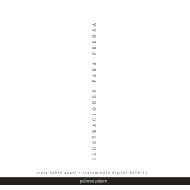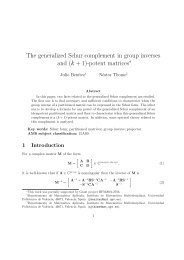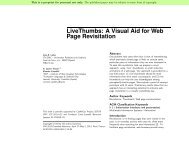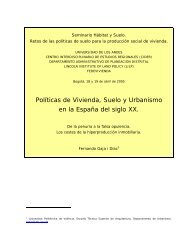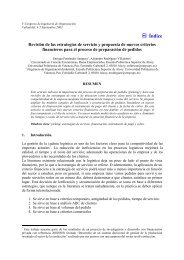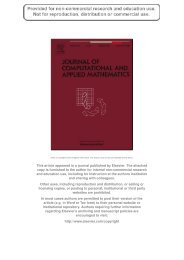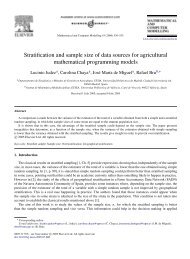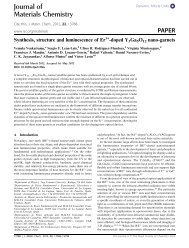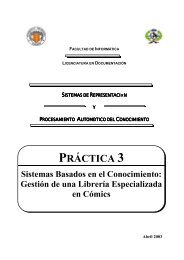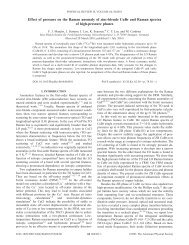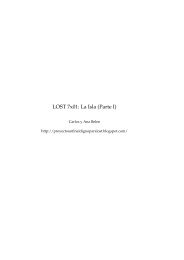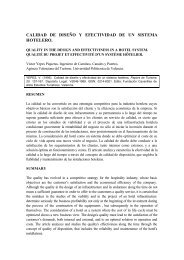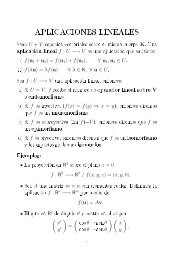Introduction to the resistivity surveying method. The resistivity of ...
Introduction to the resistivity surveying method. The resistivity of ...
Introduction to the resistivity surveying method. The resistivity of ...
Create successful ePaper yourself
Turn your PDF publications into a flip-book with our unique Google optimized e-Paper software.
35<br />
2.7.11 Wenner Gamma array survey - Nigeria<br />
Technically, <strong>the</strong> “normal” Wenner array is <strong>the</strong> Wenner Alpha array (Figure 2a). As<br />
with any four electrodes array, <strong>the</strong>re are two o<strong>the</strong>r possible variations that are usually referred<br />
<strong>to</strong> as <strong>the</strong> Beta and Gamma configurations (Carpenter and Habberjam 1956). <strong>The</strong> Wenner Beta<br />
array (Figure 2b) is in fact a special case <strong>of</strong> <strong>the</strong> dipole-dipole array. <strong>The</strong> Wenner Gamma<br />
array (Figure 2c) has a relatively unusual arrangement where <strong>the</strong> current and potential<br />
electrodes are interleaved. Compared <strong>to</strong> <strong>the</strong> Wenner Alpha and Beta (dipole-dipole) arrays,<br />
<strong>the</strong> Wenner Gamma array is much less frequently used in field surveys. However, in some<br />
situations, <strong>the</strong>re might be some advantage in using this array. <strong>The</strong> depth <strong>of</strong> investigation is<br />
significantly deeper than <strong>the</strong> Wenner Alpha array (0.59a compared <strong>to</strong> 0.52a, see Table 2), but<br />
<strong>the</strong> voltage measured between <strong>the</strong> potential electrodes is only about 33% less than <strong>the</strong> Alpha<br />
array. In comparison, <strong>the</strong> voltage that would be measured by <strong>the</strong> Wenner Beta array is onethird<br />
that <strong>of</strong> <strong>the</strong> Alpha array which could be a serious disadvantage in noisy environments.<br />
Figure 27a shows <strong>the</strong> Wenner Gamma array pseudosection from a groundwater survey<br />
in <strong>the</strong> Bauchi area <strong>of</strong> Nigeria (Acworth 1981). In this region, groundwater is frequently found<br />
in <strong>the</strong> wea<strong>the</strong>red layer above <strong>the</strong> crystalline bedrock. <strong>The</strong> wea<strong>the</strong>red layer is thicker in areas<br />
with fractures in <strong>the</strong> bedrock, and thus such fractures are good targets for groundwater. In this<br />
area, <strong>the</strong> surveys were carried out with <strong>the</strong> Wenner Alpha, Beta and Gamma arrays, <strong>to</strong>ge<strong>the</strong>r<br />
with electromagnetic pr<strong>of</strong>iling measurements using a Geonics EM34-3 system (Acworth<br />
1999). Here, only <strong>the</strong> result from <strong>the</strong> Wenner Gamma array data set is shown as an example.<br />
To emphasize <strong>the</strong> boundary between <strong>the</strong> soil layer and <strong>the</strong> bedrock, <strong>the</strong> robust<br />
inversion option was used (section 2.6.2). <strong>The</strong> inversion model in shown in Figure 27b. <strong>The</strong><br />
thickness <strong>of</strong> <strong>the</strong> lower <strong>resistivity</strong> wea<strong>the</strong>red layer is generally about 10 <strong>to</strong> 20 metres. <strong>The</strong>re is<br />
a narrow vertical low <strong>resistivity</strong> zone with a width <strong>of</strong> less than 20 metres below <strong>the</strong> 190<br />
metres mark which is probably a fracture zone in <strong>the</strong> bedrock. A borehole well that was<br />
placed at <strong>the</strong> 175 metres mark which lies just at <strong>the</strong> edge <strong>of</strong> <strong>the</strong> fracture zone. It had yields<br />
that were somewhat lower than expected (Acworth 1999). In such a situation, <strong>the</strong> 2D<br />
<strong>resistivity</strong> model would be useful <strong>to</strong> pinpoint <strong>the</strong> exact location <strong>of</strong> <strong>the</strong> centre <strong>of</strong> <strong>the</strong> fracture<br />
zone <strong>to</strong> improve <strong>the</strong> yield from <strong>the</strong> borehole. <strong>The</strong> placement <strong>of</strong> <strong>the</strong> well was largely based on<br />
<strong>resistivity</strong> and EM pr<strong>of</strong>iling data, and many years before 2D <strong>resistivity</strong> inversion s<strong>of</strong>tware and<br />
fast microcomputers were widely available.<br />
Figure 27. Bauchi Wenner Gamma array survey. (a). Apparent <strong>resistivity</strong> pseudosection. (b)<br />
<strong>The</strong> inversion model with <strong>to</strong>pography. Note <strong>the</strong> location <strong>of</strong> <strong>the</strong> borehole at <strong>the</strong> 175 metres<br />
mark.<br />
Copyright (1999-2001) M.H.Loke



